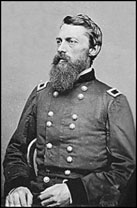Colonial Wars |
American Wars |
Link To This Page — Contact Us —
Major General George Stoneman
 |
| NAME |
| Stoneman, George |
| BORN |
| August 22, 1822 Busti, New York |
| DIED |
| September 5, 1894 Buffalo, New York |
| ARMY |
| Union |
Stoneman was the first of 10 children. His parents were George Stoneman, Sr, a lumberman and justice of the peace, and Catherine Rebecca Cheney. He studied at the Jamestown Academy and graduated from West Point in 1846, ranked 33 out of 59 in his class. His first assignment was with the 1st U.S. Dragoons, with which he served across the West and in California. He fought in the Indian Wars and was responsible for survey parties mapping the Sierra Nevada range for railroad lines.
At the start of the Civil War, Stoneman was in command of Fort Brown, Texas, and refused to surrender to the Confederate authorities there, escaping to the north with most of his command. Returning east, he served as a major of the 1st U.S. Cavalry and then adjutant to Major Gen. George B. McClellan in western Virginia. As the cavalry was being organized in the Army of the Potomac, he commanded the Cavalry Reserve and then the Cavalry Division, with the title Chief of Cavalry. He was promoted to Brigadier General on August 13, 1861. He did not relate well to McClellan, who did not understand the proper use of cavalry in warfare, relegating it to assignment in small units to infantry brigades. This organization fared poorly in the Peninsula Campaign and the Seven Days Battles of 1862, where the Confederate cavalry dominated the battlefields.
On November 22, 1861, Stoneman married Mary Oliver Hardisty of Baltimore. They eventually had 4 children.
After the Peninsula Campaign, Stoneman became an infantry commander, commanding a division in the II Corps and the III Corps. At the Battle of Fredericksburg, he commanded the III Corps. He was promoted to major general of volunteers on November 29, 1862. Major Gen. Joseph Hooker had a better understanding of the strategic value of a centralized Cavalry corps and named Stoneman to command it. The centralized corps could undertake long raids into Confederate territory, destroying supplies, and gathering intelligence about the Confederate forces.
At the Battle of Chancellorsville, Hooker assigned Stoneman a key role in which his Cavalry Corps would raid deeply into Gen. Robert E. Lee's rear and destroy vital railroad lines and supplies, distracting Lee from Hooker's main assaults. The Cavalry Corps got off to a good start in May, but quickly bogged down after crossing the Rapidan River. During the battle, Stoneman accomplished little and was considered one of the principal reasons for the Union defeat. That is the version that Hooker promulgated widely. Hooker needed to deflect criticism from himself and relieved Stoneman from his cavalry command, sending him back to Washington, D.C., for medical treatment, where he became a Chief of the U.S. Cavalry Bureau. A large cavalry supply and training depot on the Potomac River was named Camp Stoneman in his honor.
In early 1864, Stoneman requested another field command from Major Gen. John Schofield, who was in command of the Department of the Ohio. Although originally slated for an infantry corps, Stoneman assumed command of the Cavalry Corps of what would be known as the Army of the Ohio. In the Atlanta Campaign, under Major Gen. William T. Sherman, Stoneman and his aide, Brigadier Gen. Edward M. McCook, were captured by Confederate soldiers outside Macon, Georgia, becoming the highest ranking Union prisoner of war.
Stoneman was exchanged relatively quickly based on the personal request of Sherman to the Confederates and he returned to duty. He led raids into Virginia and North Carolina in 1865 and his command nearly captured President Jefferson Davis. In June 1865, he was appointed commander of the Department of Tennessee and administered occupied Memphis. There, riots broke out among citizens who were angry at the presence of black Union soldiers in the military government. He was criticized for inaction and was investigated by a congressional committee, although he was exonerated.
In 1866, Stoneman became opposed to the radical policies of Reconstruction and joined the Democratic Party. As he administered the military government in Petersburg, Virginia, he established a reputation of applying more moderate policies than some of the other military governors in Reconstruction, which eased some of the reconciliation pain for Virginians.
Stoneman was mustered out of volunteer service in September 1866, and reverted to his Regular Army rank of Lieutenant Colonel. He took command of the Department of Arizona, First Military District, headquartered at Drum Barracks. He was a controversial commander in that role because of his dealings with Indian uprisings and he was relieved of his command in May 1871.
Stoneman moved to California, the place of which he had dreamed since his service as a young officer before the war. He and his wife settled in the San Gabriel Valley on a 400 acre estate called Los Robles. He was a California Railroad Commissioner from 1876-78.
In 1882, Stoneman was elected governor of California and served a single 4-year term. He was not renominated by his party for a second term. After his house was destroyed by fire, he was broken financially and in poor health. He returned to New York for medical treatment. He died following a stroke and is buried in the Bentley Cemetery in Lakewood, New York.
Promotions:
- Major- ??
- Brigadier General USV- August 13, 1861
- Major General USV- November 29, 1862
Major Commands:
- Cavalry Reserve, Army of the Potomac
- Cavalry Division, Army of the Potomac
- Division, II Corps
- Division, III Corps
- III Corps
- Chief of the U.S. Cavalry Bureau
- Cavalry Corps, Army of the Ohio
- Department of Tennessee
